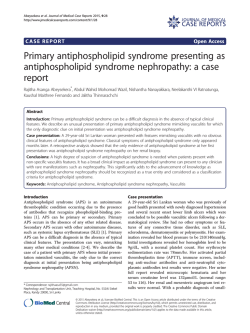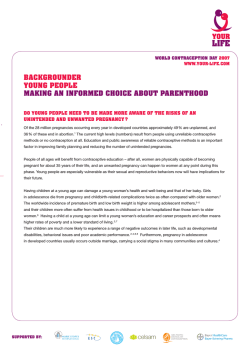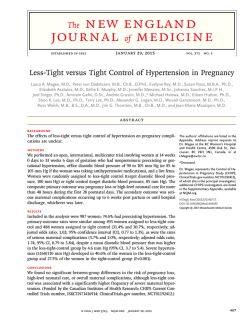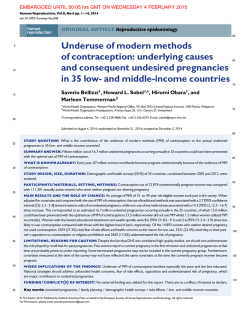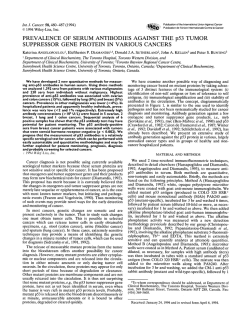
Relationship of Antiphospholipid Antibodies to Pregnancy
From www.bloodjournal.org by guest on February 6, 2015. For personal use only. Relationship of Antiphospholipid Antibodies to Pregnancy Loss in Patients With Systemic Lupus Erythematosus: A Cross-Sectional Study By Jeffrey S.Ginsberg, Patrick Brill-Edwards, Marilyn Johnston, Judah A. Denburg, Maureen Andrew, Robert F. Burrows, William Bensen, Alfred Cividino, and Aidan A. Long To determine whether an association exists between the presence of antiphospholipid antibodies and pregnancy loss, a cross-sectional study was performed. Consecutive women who were referred t o three outpatient rheumatology clinics and who had systemic lupus erythematosus (SLE) and a history of one or more pregnancies were evaluated. Patients were interviewed t o determine outcomes of all previous pregnancies. Blood was taken on t w o separate occasions at least 3 months .apart t o test for the presence of the lupus anticoagulant and anticardiolipin antibodies; on both occasions, five tests of the lupus anticoagulant, with well-defined normal ranges, and an enzyme-linked immunosorbent assay t o measure IgG anticardiolipin antibodies were performed. Patients were considered t o be positive for the lupus anticoagulant if one or more tests was abnormal on both occasions and positive for anticardiolipin antibodies if the test was abnormal on both occasions. Forty-two women were studied. Statistically significant associations were shown between lupus anticoagulant positivity and previous pregnancy loss (odds ratio [OR], 4.8; 95% confidence intervals [CI], 1.0 t o 23.6; P = .05) and between anticardiolipin antibody posi- tivity and previous pregnancy loss (OR, 20.0; 95% CI, 1.3 t o 97.0; P = .01). All seven women with multiple episodes of pregnancy loss were lupus anticoagulant positive and four of these were also anticardiolipin antibody positive. If patients who are transiently positive for lupus anticoagulant and/or anticardiolipin antibodies are considered t o be test positive, the associations with pregnancy loss are no longer statistically significant. Within the group of lupus anticoagulantpositive patients, we observed stronger associations between the presence of six or more positive tests and pregnancy loss than between the presence of t w o t o five positive tests and pregnancy loss. No single test for the lupus anticoagulant provides a statistically significant association with pregnancy loss. The results of our study show that by performing multiple lupus anticoagulant tests and by repeating testing for lupus anticoagulant and anticardiolipin antibodies on more than one occasion, significant associations between the presence of antiphospholipid antibodies and previous pregnancy loss can be shown in patients with SLE. o 1992by The American Society of Hematology. A and thromboembolic complications, has not been clearly NTIPHOSPHOLIPID antibodies bind to charged phosestablished. pholipids and inhibit phospholipid-dependent coaguWe have previously shown the importance of using a lation tests in vitro.lJ In recent years, several studies have comprehensive array of assays on at least two separate reported on the possible association between the presence of antiphospholipid antibodies and pregnancy w a ~ t a g e . ~ - ' ~occasions when looking for clinical associations of antiphospholipid antib0dies.3~We observed that reliance on a single However, a recent study critically reviewed the studies that measurement at a single time point, which may yield a have reported on this possible association and concluded transiently positive result, has the potential to obscure the that an association is suggested but not firmly supported.19 association between the presence of antiphospholipid antiSix retrospective studies of patients with systemic lupus bodies and thromboembolic complications. Although it has erythemotosus (SLE) were reviewed; two reported no been recognized that titers of anticardiolipin antibodies association between antiphospholipid antibodies and pregmay fluctuate in a given patient,17 the clinical relevance of nancy loss and four reported nonsignificant t r e n d ~ . ~ l JA~ - ' ~ transiently versus repeatedly abnormal tests with respect to limited number of patients has been studied prospectively fetal loss is unknown. In the studies mentioned above, and, to date, it has not been possible to conclusively addressing the possible association between antiphosphoestablish the presence of antiphospholipid antibodies as an lipid antibodies and pregnancy loss, the investigators did independent risk factor for adverse pregnancy outcome. not perform antiphospholipid antibody assays on more than Despite the lack of convincing evidence for an association a single occasion and did not use multiple assays for the between the presence of antiphospholipid antibodies and lupus anticoagulant. pregnancy loss, many experts believe such an association To determine whether an association between pregnancy exists.20-22 Further, therapeutic interventions aimed at preventing pregnancy loss with agents such as acetylsalicylic acid (ASA), prednisone, and gammaglobulin have been From the Departments of Medicine, Obstetrics and Gynecology, and evaluated in women with antiphospholipid antibodies and a Pediatrics, McMaster University, Hamilton, Ontario, Canada. history of pregnancy I O S S . ~ ~ - ~ Submitted May 28, 1991; accepted April 24, I992. There is a lack of agreement among experts concerning Supported in part by the Physicians' Services Incorporated Foundaboth the optimum laboratory assays to detect antiphosphotion. ~ ~ - ~ ~ Address reprint requests to Jefiey S. Ginsberg, MD, Department of lipid antibodies and the optimum pattern of t e ~ t i n g .The Medicine, McMaster University Medical Centre, 1200 Main St U: Rm presence of these antibodies is usually inferred by perform3 WI5, Hamilton, Ontario, Canada LSN 325. ing one or more coagulation assays for the lupus anticoaguThe publication costs of this article were defrayed in part by page lant and/or by performing an enzyme-linked immunosorcharge payment. This article must therefore be hereby marked bent assay (ELISA) to detect anticardiolipin antibodies. "advertisement" in accordance with 18 U.S.C. section 1734 solely to Many in vitro tests of the lupus anticoagulant have been indicate this fact. described but the test, or combination of tests, that corre0 1992 by TheAmerican Society of Hematology. lates best with clinical complications, including fetal loss 0006-497119218004-0027$3.00/0 Blood, VOI 80, NO4 (August 15). 1992: pp 975-980 975 From www.bloodjournal.org by guest on February 6, 2015. For personal use only. GINSBERG ET AL 976 loss and antiphospholipid antibodies exists in patients with SLE, we have performed a cross-sectional study in consecutive women with SLE and a history of one or more pregnancies. These women were evaluated using a combination of five tests for the lupus anticoagulant and an ELISA to detect IgG anticardiolipin antibodies and the tests were performed on two separate occasions at least 3 months apart. MATERIALS AND METHODS Study Population The study population consisted of consecutive female patients with SLE and a history of at least one pregnancy referred to three rheumatology clinics between March 1, 1987 and April 1, 1988 in Hamilton, Ontario, Canada. All patients fulfilled the 1982 revised American Rheumatism Association (ARA) criteria for SLE3I and patients with lupus-like disorders who failed to fulfil these criteria were excluded. The patients were referred because of their SLE and were not selected because they had antiphospholipid antibodies or a history of pregnancy loss. Intervention Eligible patients were interviewed by investigators, blinded to the results of testing for antiphospholipid antibodies, to determine details of the outcomes of all previous pregnancies. The outcomes were corroborated in all cases by review of medical charts, which were available for all patients. An abortion was defined as a pregnancy loss occurring before week 20 of gestation and a stillbirth as a pregnancy loss occurring after week 20 of gestation. All patients had blood drawn at their initial visit and again on a separate occasion at a follow-up visit at least 3 months after the initial visit (mean, 4 months; range, 3 to 6 months). Patients who had blood drawn on only one occasion were excluded from the study (nine patients). Laboratory Methods Lupus anticoagulant. Blood was drawn into a vacutainer tube (Becton Dickinson no. 6-416; Becton Dickinson, Mississauga, Canada) containing 0.102 mol/L buffered citrate. Plasma was immediately separated from cellular elements by centrifugation at 1,700g for 15 minutes at room temperature, with maximal removal of platelets being assured by the use of Sure-sep (Organon Teknika, Scarborough, Canada), a silicone based gel, during centrifugation. Plasma was subsequently aliquotted and frozen until batch assays were performed. The assays used to determine lupus anticoagulant activity were: (1) Xa clotting time (XaT)32was performed using purified human Xa and human phospholipid prepared by the method of Bell and Alt0n.3~In brief, 50 pL of patient plasma was added to 100 ILLof the Xa/phospholipid mixture, incubated for 60 seconds at 37"C, followed by the addition of 100 ILLof 0.025 mol/L CaC12.Results of greater than 72 seconds (2 standard deviations above the mean of 39 normal volunteers) were considered abnormal. (2) The Kaolin Cephalin activated partial thromboplastin time (KCPTT) was performed as previously de~cribed?~ using a reagent prepared at McMaster University using a human brain phospholipid preparation and 4% kaolin in saline. Results of greater than 75 seconds (2 standard deviations above the mean of 39 volunteers) were considered abnormal. (3) The activated partial thromboplastin time (aPTT), was performed using a commercially available reagent, automated aP'IT (Organon Teknica), as previously described.34Results of greater than 32 seconds (2 standard deviations above the mean of 39 normal volunteers) were considered abnormal. (4) Dilute Russell viper venom time (RVVT) was performed as previously described.**If the observed clotting time was greater than the upper limit of normal for our laboratory (44 seconds, based on 2 standard deviations above the mean of 39 normal volunteers), ionophore-treated platelets were substituted for the bovine phospholipid and the test was repeated. Results of less than 33 seconds (2 standard deviations above the mean of 38 normal volunteers) were considered abnormal. (5) Dilute one-stage prothrombin time (DPT) was performed using a 1/500 dilution of rabbit brain thromboplastin (Dade Thromboplastin C; Baxter Diagnostics, Mississauga, Canada) in a saline/CaClz mixture.3s Results of greater than 61 seconds (2 standard deviations above the mean of 41 normal volunteers) were considered abnormal. With the exception of the R W T , all patient samples were run neat and in a 1:l mix of normal pooled plasma and patient plasma. The normal pooled plasma consisted of 20 normal hospital personnel processed to assure minimal platelet activation. The pooled plasma was frozen in small aliquots at -70°C. Values for the 1:l mix above the defined upper limit of normal for each test (except the R W T ) were considered positive for the lupus anticoagulant. All lot numbers of reagents were constant for the duration of the study. Patients were considered to be repeatedly positive for lupus anticoagulant if one or more of the tests was positive on both occasions. Thus, patients with one test positive on the first occasion and another test positive on the second occasion were considered to be repeatedly positive. On the other hand, patients were considered to be transiently positive for lupus anticoagulant if one or more of the tests was positive on one occasion and all tests were negative on the other. Finally, patients were considered lupus anticoagulant negative if all five tests were normal on both occasions. Anticardiolipin antibodies. The detection and quantitation of IgG anticardiolipin antibodies was performed using an ELISA technique similar to that described by Loizou et aP6 with minor modifications. Briefly, 25 ~1 of 100 mg/ml cardiolipin (Sigma Chemicals, St Louis, MO) in ethanol was coated on polystyrene microlitre wells (Immulon I; Dynatech Laboratories, Fisher Scientific, Unionville, Canada) and evaporated under current of air. After washing in phosphate-buffered saline (PBS), the plates were blocked for 2 hours with 10% adult bovine serum in PBS (ABSPBS) and washed three times with PBS. Fifty-microliter aliquots of each serum sample diluted 1/50 in ABS-PBS were added to duplicate wells on the plates and incubated for 1 hour at room temperature. After washing five times with PBS, alkaline phosphatase-conjugated affinity-purified rabbit antihuman IgG (diluted 1/350 in ABS-PBS) was added and incubated for 1 hour at room temperature, with the addition of alkaline phosphatase substrate (1.5 Fg/mL in diethanolamine buffer pH 9.8) after five further washes with PBS. After 30 minutes of incubation in the dark at room temperature, absorbance was read at 405 nm. Mean values of the duplicates greater than four standard deviations above the mean of 55 normal sera (obtained from the blood bank at the Canadian Red Cross, Hamilton, Ontario, Canada) were considered raised (namely, optical density at 405 nm of greater than 0.58). Known positive and negative controls were included on each ELISA plate as references. Patients were considered to be repeatedly positive for anticardiolipin antibodies if the assays were positive on both occasions measured, whereas they were considered to be transiently positive if the tests were positive on one occasion and negative on the other. Patients were considered negative for anticardiolipin antibodies if testing was normal on both occasions. From www.bloodjournal.org by guest on February 6, 2015. For personal use only. 977 ANTIPHOSPHOLIPID ANTIBODIES, PREGNANCY, AND SLE Statistics The primaly analyses were to compare (1) pregnancy outcomes in patients who were repeatedly lupus anticoagulant positive with those who were transiently positive or negative for lupus anticoagulant and (2) pregnancy outcomes in patients who were repeatedly anticardiolipin antibody positive with those who were transiently positive or negative for anticardiolipin antibodies. Odds ratios and their corresponding 95% confidence intervals (CI) were calculated where indicated. An odds ratio (OR) was considered statistically significant when the lower limit of the 95% CI was 2 1.0. The xz tests and Fisher exact tests were used where indicated. A P value of less than .05 was considered to be statistically significant. No. of Episodes of Pregnancy Loss per Patient 21 0 LA+ 10 a 5 19 (OR, 4.8: 95% CI, 1.0-23.6; P = .05*) - 5 13 0 24 (OR, 20.0; 95% CI, 1.3-97.0; P = .Olt) ACLA+ - Abbreviations: LA, lupus anticoagulant;ACLA, anticardiolipinantibodrepeatedly positive; -, negative or transiently positive. ies; *,y2 test. tFisher exact test. +, RESULTS Forty-two women were studied, of whom five had one previous pregnancy, 19 had two previous pregnancies, nine had three previous piegnancies, three had four previous pregnancies, two had five previous pregnancies, three had six previous pregnancies, and one had 12 previous pregnancies. There were 11 women with one pregnancy loss; one had one previous pregnancy, four had two previous pregnancies, four had three previous pregnancies, and two had five previous pregnancies. There were three women who had lost two of two pregnabcies, one had lost all three pregnancies, two had lost three of six pregnancies, and one had lost 6 of 12 pregnancies. Of the 122 pregnancies, 30 had resulted in spontaneous abortions and two had resulted in stillbirths, yielding an overall pregnancy loss rate of 26.2%. Of the 42 women, 11 had a histoty of one previous pregnancy loss and seven had a history of two or more episodes of pregnancy loss. Pregnancy Loss and Lupus Anticoagulant A summary of the antiphospholipid antibody testing and the pregnancy outcomes is provided in Table 1. There were 15 women who showeu repeat lupus anticoagulant positivity, four who showed transient lupus anticoagulant positivity, and 23 who showed lupus anticoagulant negativity. All seven of the women experiencing multiple pregnancy losses showed repeatedly positive testing for the lupus anticoagulant (OR, 47; 95% CI, 2.4 to 923.9;P = .003). Table 2 shows the significant relationship between repeat lupus anticoagulant positivity and history of pregnancy loss (OR, 4.8; 95% Table 1. Pregnancy Loss and Antiphospholipid Antibody Results No. of Episodes of Pregnancy Loss per Patient >1 Table 2. Relationship Between Antiphospholipid Antibodies and Pregnancy Loss 1 0 1 APLA test results LA+ ACLA+ LA+ ACLALA- ACLA+ LA- ACLA- 4 3 0 0 2 0 5 0 8 0 19 Total 7 11 24 Abbreviations: APLA, antiphospholipid antibody: LA, lupus anticoagulant; ACLA, anticardiolipin antibody; +, repeatedly positive (see Materials and Methods); -, negative or transiently positive (see Materials and Methods). CI, 1.0 to 23.6; P = .05).If transiently lupus anticoagulantpositive patients are grouped with repeatedly positive patients, the OR decreases to 3.8 (95% CI, 0.8 to 17.4; P = .OS), corroborating the hypothesis that repeat positivity is more strongly associated with fetal loss than transient positivity. A history of pregnancy loss occurred in 24 of the 55 pregnancies in women with repeat lupus anticoagulant positivity compared with 8 of the 67 pregnancies in lupus anticoagulant-negative women (OR, 5.7; 95% CI, 2.3 to 13.9;P < .0001). Pregnancy Loss and Anticardiolipin Antibodies There were five women who were repeatedly positive for anticardiolipin antibodies, all of whom had one or more episodes of previous pregnancy loss, compared with 13 of the 37 antibody negative or transiently positive women who had one or more episodes of previous pregnancy loss (OR, 20.0; 95% CI, 1.3 to 97.0;P = .01; Table 2). There were five women who had transient antibody positivity, one of whom had previous pregnancy loss. If patients who are transiently positive for anticardiolipin antibodies are grouped with patients who are repeatedly positive, the OR decreases to 3.5 (95% CI, 0.5 to 22.3; P = .14), corroborating the hypothesis that repeat antibody positivity is more strongly associated with pregnancy loss than transient positivity. Ten of the 14 pregnancies in the women who were repeatedly positive for anticardiolipin antibodies resulted in pregnancy loss compared with 22 of the 108 pregnancies in antibody-negative or transiently positive women (OR, 9.8; 95% CI, 3.0 to 32.4; P = .002). One of the 12 pregnancies in a women who was transiently antibody positive resulted in pregnancy loss. Of note is that all women who were positive for anticardiolipin antibodies were also positive for lupus anticoagulant. Of the five women who tested repeatedly positive for anticardiolipin antibodies, four had high titres ( > 6 SD above the mean) on both occasions and one had a high titre on one occasion and a low titre (4 SD above the mean) on the second occasion. Three of the four women with persistently high-titre antibodies had suffered multiple pregnancy losses and the fourth had suffered one pregnancy loss, From www.bloodjournal.org by guest on February 6, 2015. For personal use only. 978 GINSBERG ET AL whereas the one woman with mixed titres had suffered multiple pregnancy losses. The small number of study participants with anticardiolipin antibodies does not allow us to determine whether there is a relationship between the titre of anticardiolipin antibodies and the risk of pregnancy loss. Pattems of Lupus Anticoagulant Results Of the 15 women with repeat lupus anticoagulant positivity, five had identical patterns of testing at both times of testing, whereas 10 had different patterns of positivity. Details of the results of each of the tests in patients who were repeatedly positive are shown in Table 3. Based on the results we are unable to show that one test is clearly superior. Of those four women who exhibited transient positivity for lupus anticoagulant, two had a single abnormal test and two had two abnormal tests. Of the women who were repeatedly positive for lupus anticoagulant, there were five episodes of pregnancy loss in 20 pregnancies in women who had a total of two to five positive tests compared with 19 episodes of pregnancy loss in 35 pregnancies in women who had a total of 6 to 10 positive tests (OR, 3.6; 95% CI, 1.1to 11.5; P = .03). Table 4 summarizes the prevalences of repeatedly abnormal individual tests in patients with pregnancy loss and the ORs for the associations between repeat test positivity for each test and previous pregnancy loss. It is observed that combining five tests provides the greatest sensitivity for previous pregnancy loss and the only statistically significant OR. This supports the hypothesis that a combination of tests is superior to a single test for lupus anticoagulant when describing clinical associations. The use of corticosteroid therapy has the potential to affect the results of antiphospholipid antibodies testing in SLE patients. Of the 42 study patients, 15 were taking daily doses of prednisone and one patient was taking prednisone and azathioprine. There were two of four patients who were transiently positive for lupus anticoagulant taking corticosteroids compared with 6 of 15 who were repeatedly positive and 8 of 23 who were persistently negative. There were three of five patients who were transiently positive for anticardiolipin antibodies taking corticosteroids, compared with two of five who were repeatedly positive and 11 of 32 who were persistently negative. There are no significant differences in the proportion of patients taking corticosteTable 3. Individual LA Tests in LA-PositiveWomen No. of LA+ Patients Test XaT KCPTT aPTT RVVT DPT With Repeatedly Abnormal Tests ( O h ) 5/15 9/15 7/15 7/15 9/15 (33.3) (60.0) (46.7) (46.7) (60.0) No. of LA+ Patients With Transiently Abnormal Test ( O h ) No. of LA+ Patients With Abnormal Tests ( O h ) 6/15 2/15 5/15 5/15 4/15 11/15(73.3) 11/15 (73.3) 12/15 (80.0) 12/15 (80.0) 13/15 (86.6) (40.0) (13.3) (33.3) (33.3) (26.7) Abbreviations: LA,lupus anticoagulant; f , repeatedly positive. Table 4. Performanceof Individual LA Tests No. of Patients With Pregnancy Loss When Test Was Repeatedly Abnormal Test(s) (04 OR (95% CI) XaT KCPTT a PTT RWT DPT All tests combined 4/18 (22.2) 6/18 (33.3) 4/18 (22.2) 6/18 (33.3) 6/18 (33.3) 10/18 (55.6) 6.6 (ns) (0.4-182.8) 3.5 (ns) (0.5-22.3) 2.0 (ns) (0.3-13.8) 11.5 (ns) (0.8-305.0) 3.5 (ns) (0.5-22.3) 4.8 (SS)(1.O-23.6) Abbreviations: ns, not statistically significant (lower 95% CI on OR is < 1.0); ss, statistically significant (lower 95% CI on OR is 2 1.0) roid therapy among the different patterns of testing, suggesting that corticosteroid and immunosuppressive therapy did not substantially alter the pattern of antiphospholipid antibody testing in our patients. DISCUSSION The results of our study show significant associations between repeat lupus anticoagulant and anticardiolipin antibody positivity and a history of previous pregnancy loss in women with SLE. All seven women with multiple episodes of pregnancy loss were repeatedly positive for lupus anticoagulant and four of these women were also persistently positive for anticardiolipin antibodies. As previously observed in a study examining the association between antiphospholipid antibodies and thromboembolic disease,30 the performance of repeat testing is important because the association between repeat test positivity and pregnancy loss is stronger than the association between transient test positivity and pregnancy loss. The performance of several assays for lupus anticoagulant shows a much stronger association (greater sensitivity) for previous pregnancy loss than the performance of single assays. Furthermore, within the group of lupus anticoagulantpositive patients, the association is stronger when a greater number of different assays is abnormal as we observe stronger correlations between the presence of six or more positive tests and pregnancy loss than between the presence of two to five positive tests and pregnancy loss. The study design chosen was cross-sectional rather than cohort because the cross-sectional study is more efficient. Because of the design, great care was taken to minimize bias in order to provide valid conclusions. Patient selection and referral bias were minimized by entering consecutive patients into the study from clinics that do not have specific interests in antiphospholipid antibodies or obstetric complications. The investigators performing the interviews were blinded to the laboratory results of the patients and the laboratory personnel performing the assays were blinded to the clinical status of the patients. It is likely that reliance on interviews for the collection of obstetrical data is reasonable and likely to be accurate because women are unlikely to forget previous abortions or stillbirths. Although women may have been reluctant to disclose information pertaining to previous pregnancies to From www.bloodjournal.org by guest on February 6, 2015. For personal use only. ANTIPHOSPHOLIPID ANTIBODIES, PREGNANCY, AND SLE the investigators, the information obtained was corroborated in all cases by the review of medical records. The greatest limitation of the cross-sectional design used in this study is the inability to establish a temporal relationship between antiphospholipid antibody testing and obstetrical complications. The study population was a group of women with a wide age range (25 to 61 years) when entered into the study. The patients had had the diagnosis of SLE made for between 1 month and greater than 20 years. Therefore, a small proportion of the women had not even been diagnosed with SLE during their pregnancies. Testing was performed from 30 years after the last pregnancy to immediately postpartum. Thus, we are unable to determine when the assays became abnormal in women who tested positive in this study and whether these tests became abnormal before or after their pregnancies. It is possible (and perhaps likely) that some women who were negative or transiently positive when tested in the study were abnormal when they were pregnant. Additionally, we cannot exclude the possibility that pregnancy events cause test positivity rather than vice versa, although such a relationship seems unlikely. The best study design to clearly establish the temporal relationship between the diagnosis of SLE, antiphospholipid antibodies, and obstetrical complications is prospective cohort. The results of our study are weighed relatively heavily by the women with multiple pregnancy losses, all of whom were positive for both lupus anticoagulant and anticardiolipin antibodies or a lupus anticoagulant alone. Because the women in this study were not evaluated for other causes of habitual abortion, such as husband-wife immunologicincompatibilities, it is not possible to exclude these as causes of habitual abortions in this study. The results of our study show an association but not a cause and effect relationship between antiphospholipid antibodies and pregnancy loss; such as relationship could only be shown in large prospec- 979 tive cohort studies. Although our results are likely to be valid for patients with SLE, it cannot be concluded that there is an association between the presence of antiphospholipid antibodies and pregnancy loss in patients without SLE. The aim of our study was not to determine the best test for lupus anticoagulant or combination of tests that correlate with clinical outcomes. Rather, it confirms our hypothesis that a combination of tests is superior to a single test and that testing on more than a single occasion increases the strength of the clinical associations. No single test provides significant superiority over any other test, although the relatively small number of patients evaluated does not allow us to exclude the possibility that one test is superior to another. The variability of test positivity between patients and within the same patient, over time, suggests variability in the titer of antibodies and heterogeneity of the antibodies being detected. Although we cannot exclude an effect on test results due to corticosteroid or immunosuppressive therapy, we do not believe that this biases the results of the study because there was no clear relationship between the use of these agents and patterns of anticardiolipin antibody testing. It is likely that the results of our study can be extrapolated to most populations of SLE patients because a proportion of patients in most SLE clinics will be taking corticosteroid and/or immunosuppressive therapy. This study points to likely explanations for the lack of demonstration of an association between antiphospholipid antibody positivity and pregnancy loss in previous studies. By optimizing the pattern of testing, namely by performing multiple lupus anticoagulant tests and by repeating testing on more than one occasion, and by using rigorous laboratory methods and interpretation of the tests, the strength of the association between antiphospholipid antibody positivity and pregnancy loss can be shown. REFERENCES Spitz B, Van Assche A Arterial thrombosis, intrauterine death 1. Conley CC, Hartman R C A haemorrhagic disorder caused by circulating anticoagulant in patients with disseminated lupus erytheand ‘‘lupus’’ anticoagulant: Detection of immunoglobulin interfermatosus. J Clin Invest 31:621,1952 ing with prostacyclin formation. Lancet 1:244,1981 2. Pengo V, Thiagarajian P, Shapiro SS, Heine MJ: Immunolog9. Hedfors E, Lindahl G, Lindblad S: Anticardiolipin antibodies ical specificity and mechanism of action of IgG lupus anticoaguduring pregnancy. J Rheumatol14:160,1987 lants. Blood 70:69,1987 10. Gardlund B: The lupus inhibitor in thromboembolic disease 3. Nilsson IM, Astedt B, Hedner U, Berezin D: Intrauterine and intrauterine death in the absence of systemic lupus. Acta Med death and circulating anticoagulant (“antithromboplastin”). Acta Scand 215:293,1984 Med Scand 197153,1975 11. Boey ML, Colaco CB, Gharavi AE, Elkon KB, Loizou S, 4. Lubbe WF, Walker EB: Chorea gravidarum associated with Hughes GR: Thrombosis in systemic lupus erythematosus: Striking circulating lupus anticoagulant: Successful outcome of pregnancy association with the presence of circulating lupus anticoagulant. Br with prednisone and aspirin therapy. Case report. Br J Obstet Med J 287:1021,1983 Gynecol90:487,1983 12. Elias M, Eldor A Thromboembolism in patients with the 5. Parke A, Maier D, Hakim C, Randolph J, Andreoli J: “lupus” type circulating anticoagulant. Arch Intern Med 144:510, Subclinical autoimmune disease and recurrent spontaneous abor1984 tion. J Rheumatol13:1178, 1986 13. Colaco CB, Elkon KB: The lupus anticoagulant. A disease 6. Lubbe WF, Butler WS, Palmer SJ, Liggins G C Lupus marker in antinuclear antibody negative lupus that is cross-reactive anticoagulant in pregnancy. Br J Obstet Gynecol91:357,1984 with antoantibodies to double-stranded DNA. Arthritis Rheum 7. Branch DW, Scott JR, Kochenour NK, Hershgold E: Obstet2867,1985 ric complications associated with the lupus anticoagulant. N Engl J 14. Petri M, Rheinschmidt M, Whiting-OKeefe Q, Hellmann Med 313:1322,1985 D, Corash L The frequency of lupus anticoagulant in systemic 8. Cameras LO, Defreyn G, Machin SJ, Vermylend J, Deman R, lupus erythematosus. A study of sixty consecutive patients by From www.bloodjournal.org by guest on February 6, 2015. For personal use only. 980 activated partial thromboplastin time, Russell viper venom time and anticardiolipin antibody level. Ann Intern Med 106524,1987 15. Harris EN, Chan JK, Asherson €2.4, Aber VR, Gharavi AE, Hughes GR: Thrombosis, recurrent fetal loss, and thrombocytopenia. Predictive value of the anticardiolipin test. Arch Intern Med 146:2153,1986 16. Fort JG, Cowchock FS, Abruzzo JL, Smith JB: Anticardiolipin antibodies in patients with rheumatic diseases. Arthritis Rheum 30752,1987 17. Kalunian KC, Peter JB, Middlekauff HR, et al: Clinical significance of a single test for anti-cardiolipin antibodies in patients with systemic lupus erythematosus. Am J Med 85:602, 1988 18. Gharavi AE, Harris EN, Lockshin MD, Hughes GR, Elkon KB: IgG subclass and light chain distribution of anticardiolipin and DNA antibodies in systemic lupus erythematosus. Ann Rheum Dis 47:286,1988 19. Love PE, Santoro SA: Antiphospholipid antibodies: Anticardiolipin and the lupus anticoagulant in systemic lupus erythematosus (SLE) and in non-SLE disorders. Prevalence and clinical significance. Aan Intern Med 112:687,1990 20. Feinstein DI: Lupus anticoagulant, thrombosis and fetal loss. N Engl J Med 313:1348,1985 21. Hughes G R V Thrombosis, abortion, central disease, and the lupus anticoagulant. Br Med J 2879088,1983 22. Park AL: Antiphospholipid antibody syndromes. Rheum Dis Clin North Am 15:275,1989 23. Branch DW, Scott JR, Kochenour NK, Hershgold E Obstetrical complications associated with the lupus anticoagulant. N Engl J Med 313:1322,198$ 24. Lubbe WF, Butler WS, Palmer SJ, Liggins GC: Fetal survival after prednisone suppression of maternal lupus anticoagulant. Lancet 1:1361,1983 25. Carreras LO, Perez GN, Vega HR, Casavilla F Lupus anticoagulant and recurrent fetal loss: Successful treatment with gammaglobulin. Lancet 2:393,1988 GINSBERG ET AL 26. Green D, Hongie C, Kazmier FJ, Lechner K, Mannucci PM, Rizza CR, Sultan Y Report of the working part on acquired inhibitors of coagulation: Studies of the “lupus” anticoagulant. Thromb Haemost 49:144,1983 27. Kelsey PR, Stevenson KJ, Poller L The diagnosis of lupus anticoagulants by the activated partial thromboplastin time-The central role of phosphatidyl serine. Thromb Haemost 52:172, 1984 28. Thiagarajan P, Pengo V, Shapiro SS: The use of the dilute Russell viper venom time for the diagnosis of lupus anticoagulants. Blood 682369,1986 29. h e r T, Rickard KA, Kronenberg H: A sensitive test demonstrating lupus anticoagulant and its behavioural patterns. Br J Haematol40:143,1978 30. Long AA, Ginsberg JS, Brill-Edwards P, Johnston M, Turner C, Denburg JA, Cividino A, Andrew M, Hirsh J: The relationship of antiphospholipid antibodies to thromboembolic disease in systemic lupus erythematosus: A cross-sectional study. Thromb Haemost 66520,1991 31. Tan EM, Cohen AS, Fries JF, Masi AT, McShane DJ, Rothfield NF, Schaller JG, Tala1 N, Winchester RJ: The 1982 revised criteria for classification of systemic lupus erythematosus. Arthritis Rheum 25:1271, 1982 32. Johnston M, Carter CJ: The use of diagnostic algorithms for APTT inhibitors. IX International Congress on Thrombosis and Haemostasis 1983 (abstr) 33. Bell WN, Alton HG: A brain extract as a substitute for platelet suspension in the thromboplastin generation test. Nature 174:880,1954 34. Proctor RR, Rapaport SI: The partial thromboplastin time with kaolin. Am J Clin Pathol36:212, 1961 35. Schleider MA, Nachman RL, Jaffe EA, Coleman M: A clinical study of the lupus anticoagulant. Blood 48:499,1976 36. Loizou S, McRea DJ, Rudge AC, Reynolds R, Boyle CC, Harris E N Measurement of anti-cardiolipin antibodies by an enzymelinked immunosorbent assay: Standardization and quantitation of results. Clin Exp Immunol62:738,1985 From www.bloodjournal.org by guest on February 6, 2015. For personal use only. 1992 80: 975-980 Relationship of antiphospholipid antibodies to pregnancy loss in patients with systemic lupus erythematosus: a cross-sectional study [see comments] JS Ginsberg, P Brill-Edwards, M Johnston, JA Denburg, M Andrew, RF Burrows, W Bensen, A Cividino and AA Long Updated information and services can be found at: http://www.bloodjournal.org/content/80/4/975.full.html Articles on similar topics can be found in the following Blood collections Information about reproducing this article in parts or in its entirety may be found online at: http://www.bloodjournal.org/site/misc/rights.xhtml#repub_requests Information about ordering reprints may be found online at: http://www.bloodjournal.org/site/misc/rights.xhtml#reprints Information about subscriptions and ASH membership may be found online at: http://www.bloodjournal.org/site/subscriptions/index.xhtml Blood (print ISSN 0006-4971, online ISSN 1528-0020), is published weekly by the American Society of Hematology, 2021 L St, NW, Suite 900, Washington DC 20036. Copyright 2011 by The American Society of Hematology; all rights reserved.
© Copyright 2025

